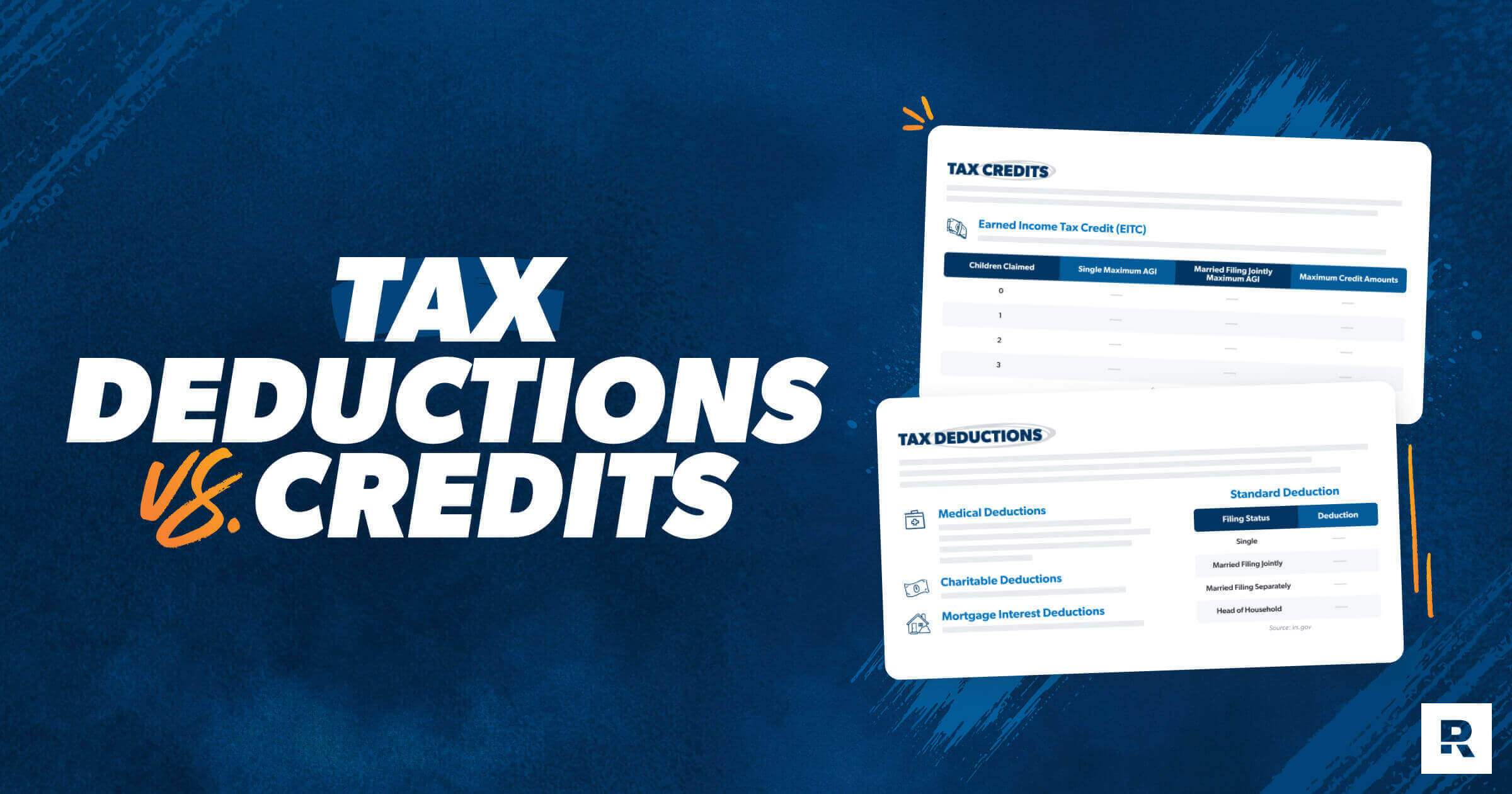Key Takeaways
- Tax deductions and tax credits can both help you save money on taxes, but they work in different ways.
- Tax deductions reduce how much of your income is taxed, while tax credits directly reduce your tax bill dollar for dollar.
- Deductions and credits are both extremely valuable, but figuring out which is more valuable depends on your financial situation, tax bracket and expenses throughout the year.
- You can maximize your savings by claiming all the deductions and credits you qualify for. Working with a trustworthy tax pro or using a solid tax filing software can keep you from missing out on any tax savings.
There’s nothing better than finding yourself in a win-win situation, like having to choose between cookies or ice cream for dessert. No matter what happens, you win. But putting a heaping scoop of ice cream on top of a freshly baked cookie? Now we’re talking!
Get expert money advice to reach your money goals faster!
Together, tax deductions and tax credits are the cookie à la mode of the tax filing experience (with none of the calories but also, admittedly, less of the fun). Why? Because both of them can save you money this tax season—and I think we can all agree that’s a really sweet deal.
Deductions lower how much of your money gets taxed, while credits cut your tax bill like Dave Ramsey chopping up credit cards. But is one better than the other? And how do you claim deductions and credits on your tax return? Let’s break it down.
What Are Tax Deductions?
Tax deductions reduce the amount you pay in taxes by subtracting certain expenses from your income. Since tax deductions lower the amount of your income that’s subject to taxes, they also lower your tax bill in the process. They could help you save hundreds, maybe even thousands, of dollars off your tax bill.
For example, if your gross income for the year was $100,000 and you claim $20,000 in tax deductions, that means you’ll be taxed on $80,000 instead of $100,000. Pretty sweet, right?
Here are some examples of common tax deductions that can lower your taxable income:
- Standard deduction (for those who don’t itemize their deductions)
- State and local tax (SALT) deduction
- Mortgage interest
- Student loan interest
- Medical and dental expenses
- Charitable contributions
- Retirement account contributions (traditional IRA, traditional 401(k) and other tax-deferred retirement accounts)
- Educator expenses
- Health savings account (HSA) contributions
What Are Tax Credits?
Tax credits are like a gift card for your taxes—they lower your tax bill dollar for dollar by subtracting the amount of your credit from your tax bill. For example, if you owe $3,000 in taxes and you get a $2,000 credit, your tax bill automatically drops to $1,000. Ta-da!
The more credits you claim, the less money you’ll owe to Uncle Sam once Tax Day rolls around. And some credits are refundable credits, which means you could end up getting some money back from the government as part of your tax refund if the amount of those credits is greater than your tax bill.
Based on your income, age or filing status, there are plenty of credits you might be able to claim on your tax return. Here are some of the most common credits out there:
- Earned income tax credit (EITC)
- Child tax credit
- American opportunity tax credit
- Lifetime learning tax credit
- Retirement savings contributions credit (saver’s credit)
- Foreign tax credit
- Child and dependent care credit
- Adoption credit
- Credit for the elderly or disabled
What’s the Difference Between Tax Deductions and Tax Credits?
First of all, tax deductions and tax credits can both save you money on your tax return. So they’re both great for your wallet! The difference, again, is how they can save you money.
Here’s the big difference between the two: While tax deductions lower your taxable income, tax credits lower your tax bill on a dollar-for-dollar basis.
To show you how those differences would impact your tax bill in real life, meet Mark and Gemma. In 2024, this happy couple had a gross household income of $150,000, which puts them in the 22% tax bracket.
Tax deductions lower your taxable income.
First, Mark and Gemma decide to take the standard deduction, which for the 2024 tax year is $29,200 for those married filing jointly. After subtracting $29,200 from their gross income, their taxable income is immediately reduced to $120,800. Since they’re in the 22% tax bracket, that one move saves them $6,424 in taxes for the year ($29,200 x 22%).
After taking the standard deduction, the amount of tax they now owe for the year is $16,682 . . . but we’re not done yet!
Tax credits lower your tax bill.
Mark and Gemma also qualify for some tax credits. They have three kids running around at home under the age of 17, which means they can claim the child tax credit (CTC) for all three of them.
For tax year 2024, the CTC is $2,000 for each qualifying child (and fun fact, $1,700 of each credit is refundable!).1 So Mark and Gemma can claim $6,000 worth of tax savings (and get up to $5,100 as a refund) thanks to the child tax credit.
Since tax credits lower your tax bill dollar for dollar, they can simply subtract that amount from their tax bill—and that lowers their overall tax bill to $10,682 ($16,682 - $6,000).
See the difference?
Which Is Better: Tax Deductions or Tax Credits?
This is kind of like asking whether cookies are better than ice cream. In the end, they’re both great—they’re just different. But there are situations where tax deductions might be more valuable than tax credits.
For example, tax deductions might be especially valuable if:
- You’re in a higher tax bracket. If you made bank last year and you’re in the 32% or 37% tax bracket, tax deductions can save you more simply because your income is being taxed at a higher rate.
- You have large deductible expenses. There might be years when you experience hefty medical bills, pay thousands of dollars in mortgage interest, or give more than normal to your church or favorite charity. In those cases, tax deductions can be extremely valuable.
- You’re self-employed or own a small business. Running a business ain’t cheap, but thankfully there are plenty of tax write-offs available for freelancers and small-business owners that help ease the sting of high business costs.
Tax credits, on the other hand, are more useful if:
- You’re in a lower tax bracket. Tax deductions are always helpful, but they’re not as helpful if you’re in a lower tax bracket where your income is taxed at a lower rate. Tax credits might come in more handy then.
- You have a large tax bill. A $1,000 tax credit chops your tax bill down by $1,000, which might feel like a bucket of cold water on a raging fire if you’re looking at a massive tax bill.
- You qualify for refundable tax credits. Even if you don’t have a large tax bill, refundable tax credits like the child tax credit or the earned income tax credit could end up putting cash back in your pocket.
The Bottom Line
At the end of the day, tax deductions and tax credits are both great for your wallet once tax season rolls around. And the best part? You don’t have to choose between the two!
With help from your favorite online tax software or a trusted tax professional, you can maximize your tax savings by claiming deductions that’ll lower your taxable income and credits that’ll reduce your tax bill dollar for dollar.
After all, why choose between cookies or ice cream when you can have both at the same time?
Next Steps
- Take a look at your eligible deductions from last year to figure out if itemizing saves you more money than the standard deduction. Most taxpayers take the standard deduction, but itemizing might be worth it if you racked up a bunch of eligible expenses.
- Find out which tax credits you qualify for—like the child tax credit if you’re a parent or one of the available education credits if you’re a student (or the parent of a student)—so you can maximize your tax savings.
- Not sure what deductions or credits apply to you? If your tax situation is a little more complicated than the average filer’s, get in touch with a RamseyTrusted® tax pro who can help you make the best tax decisions and avoid costly mistakes.
- If you’re the do-it-yourself type, get your taxes done quickly and accurately with Ramsey SmartTax. Our easy-to-use tax software will show you how to claim all your deductions and credits step by step so you don’t miss a thing.
Federal Classic Includes:
-
All major income types and federal forms
-
Prepare, print and e-file
-
Phone and email support
-
1 year of audit assistance
Federal Premium Includes:
Everything in Federal Classic plus:
-
Live chat
-
Priority phone and email help
-
Free financial coaching session
-
3 years of audit assistance
-
1 month of ID theft protection
Frequently Asked Questions
-
What’s the difference between the standard deduction and itemized deductions?
-
The standard deduction is the “easy button” of tax deductions. It automatically reduces your taxable income by a set amount (which is determined by the IRS each year) based on your filing status . That’s it? Yup, you’re done!
Itemized deductions take some work and require you to get your hands a little dirty (mostly with ink from all the paperwork you have to do). You’ll need to fill out a Schedule A form with your tax return to claim all the deductions you qualify for one by one.2
Some of the most common itemized deductions include things like medical expenses, charitable donations and mortgage interest. But you can only claim these deductions if you itemize. Once you take the standard deduction, you can’t claim any additional itemized deductions (just like with chips and salsa, no double-dipping!).
It’s really, really important to make sure you have detailed records and supporting documents—like receipts, bank statements and bills—to back up your claims for each deduction. If the IRS comes knocking, you want to make sure you can prove all the itemized deductions you claimed were legit.
-
How do I choose between the standard deduction and itemized deductions?
-
When you’re trying to decide whether to take the standard deduction or itemize your deductions, you should always pick the option that gives you the largest amount and, therefore, lowers your taxable income the most.
That means you should only itemize if the total amount of your itemized deductions adds up to more than the standard deduction. In most cases, the standard deduction is the way to go.
-
What are above-the-line deductions?
-
There are some “above-the-line” tax deductions that can help lower your taxable income even if you take the standard deduction. These include things like contributions to tax-deferred retirement accounts (like a traditional 401(k) or traditional IRA) and health savings accounts (HSAs), student loan interest and educator expenses (it’s the least the IRS can do for all the hard work teachers do).
-
What’s the difference between a refundable credit and a nonrefundable credit?
-
If you qualify for a refundable credit that’s larger than your total tax bill, you get to keep the difference as part of your refund—even if your tax bill is zero. So, if you owe $500 in taxes and you have a $1,000 refundable credit, the IRS will send you $500.
With a nonrefundable credit, unfortunately you won’t get a refund. The best-case scenario with a nonrefundable credit is that it reduces your tax bill to zero. But hey, that’s still a great deal.
And, yes, you can subtract both types of credits from your tax bill as long as you qualify for them.





